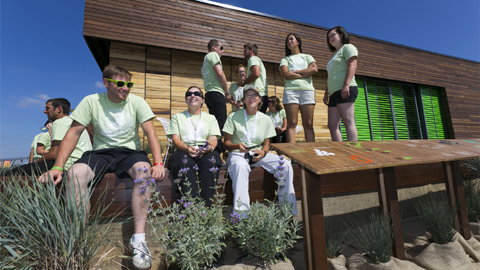Students and faculty from George Washington, Catholic and American Universities collaborated on an entry to the biennial Solar Decathlon, sponsored by the Department of Energy. The GW team, called “Team Capitol DC,” designed and built its entry “Harvest Home,” a 700-square-foot sustainable structure and garden. Harvest Home, which represented GW’s first venture into the Solar Decathlon competition, placed seventh among 20 finalists representing universities across the globe, in the final round of the competition held in Irvine, California during October 3-13, 2013.

Each team was evaluated by juries and through performance measurements in 10 categories including, architecture, market appeal, engineering, communications, affordability, comfort-zone, hot water, appliances, home entertainment and energy balance.
The scores for each individual category were combined to calculate the overall scores. Team Austria from the Vienna University of Technology took home the top prize for their home, called LISI. 2013 marked the closest competition ever with only two- to three-point differences in scoring between the top teams. The overall competition winner Team Austria, for example, received 951.9 points, while Harvest Home scored 920.3.
Harvest Home and the other 19 finalists tied for first place in the energy balance category, receiving a perfect score for having a net positive energy balance. It also received a score above 98 on a 100-point scale for appliances, home entertainment and comfort zone, placing second in these categories.
Harvest Home was built in Washington, D.C., then disassembled and flown to California, where it was reassembled in less than two weeks in the “Solar Decathlon Village,” the site of the competition in Orange County Great Park. During the competition, Team Capitol DC hosted more than 15,000 visitors through the structure.
Harvest Home’s 7.8 kilowatt array of solar panels covers the roof and stores energy during the day; the goal is a "net-zero energy" structure that produces as much energy as it consumes. The solar thermal system is responsible for heating the home's water, and is a closed loop system that does not require electricity to keep the water heated, as conventional systems do. The Harvest Home's ecologically responsible design also uses storage tanks to collect rainwater and includes gardens on the home's perimeter to supply some food for the homeowner.
After completion of the competition, Harvest Home was donated to a veteran through the Wounded Warrior Homes program, run by a nonprofit organization that assists returning U.S. military veterans who are transitioning from active-duty military service to independent living by providing affordable housing.

Professor Kim Roddis of the SEAS Civil and Environmental Engineering Department, who served as the faculty mentor for the competition, said “Knowing that Team Capitol DC's mission to provide a healing home to a wounded warrior was fully accomplished and hearing the overwhelmingly positive comments of the visiting public were the highlights of this experience.”
A video explaining the details of Harvest Home can be seen at the following link: http://inthecapital.streetwise.co/2013/08/28/au-catholic-gw-students-team-up-to-create-one-of-a-kind-energy-efficient-home-video/?utm_source=SEAS+Donor+Update+24.Sept-10-2013&utm_campaign=Donor+Update+Sept+2013&utm_medium=email
More information about the Solar Decathlon competition can be seen at the following link: http://www.solardecathlon.gov/


